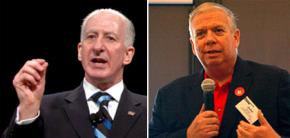UNITE HERE war gets nastier
looks at the fallout from the breakup of the UNITE HERE union--and the role of SEIU in the dispute.
THE TURMOIL created by the breakup of the UNITE HERE union continues to get worse, and the entire labor movement is suffering collateral damage as a result.
One key moment came May 29, when Bruce Raynor was forced to resign as president of the union of garment and hotel workers that was created as the result of a merger five years ago. He left the same day that an internal hearing was held by UNITE HERE officials to review charges that Raynor organized a breakaway faction to join the Service Employees International Union (SEIU).
The disciplinary hearing could have led to Raynor's expulsion--on charges that he used millions of dollars in UNITE HERE assets to fund a secession of 150,000 workers that would benefit the SEIU.
Raynor's resignation is the latest development in a months-long internal dispute within the union. In mid-March, staff loyal to the old UNITE, the garment workers union, began to hold votes for secession in their shops. Struggles for control of the shops then broke out between Raynor's fraction and staff from the former hotel workers' union, HERE. In some cases, this resulted in physical confrontations, as in UNITE HERE Local 24 in Detroit.

At the end of March, the UNITE faction held a convention in Philadelphia, declaring that it had seceded from UNITE HERE to form a new union, Workers United (WU). The WU then affiliated with the SEIU.
Two weeks before the hearing, John Wilhelm, the leader of the HERE side of UNITE HERE and president of its hospitality division, sent a team of private security guards to seize control of two floors of the union's executive offices on Seventh Avenue in New York City.
Wilhelm said the raid was necessary because the property was still that of UNITE HERE. Further, he said, Raynor's faction had been using the office as headquarters for the secessionists, and was taking vital information from UNITE HERE's computers.
According to New York Daily News columnist Juan Gonzales, "Wilhelm's people found several documents they say show Raynor was subverting his union." One memo "provides Raynor detailed updates from the Workers United breakaway group about its plans and finances," Gonzales said. The memo also reports that the WU has a monthly spending deficit of $300,000 per month and advises WU leaders to appeal to SEIU for $1.3 million a month in loans.
In the last few months, it has become increasingly clear that SEIU was playing an active role in helping the UNITE faction to break away.
In late January, SEIU President Andy Stern offered to settle the dispute in UNITE HERE by allowing it to affiliate to his union.
By early March, a secessionist campaign came into full swing to discredit Wilhelm's faction and the merger. Labor Notes magazine's Paul Abowd wrote, "[The campaign] was launched with help from Steve Rosenthal, a consultant with ties to SEIU. It included robo calls and mailings soliciting disgruntled members, and a Web site alleging lavish spending among HERE leaders."
Many of these glossy fliers were heavily shaded in purple and advised its readers to "look for organizers in the purple UNITE HERE shirts carrying petitions." After WU was formed, its staff was joined by SEIU organizers at various shops to win support for the new union.
WHAT STARTED as a civil war in UNITE HERE has deteriorated into a conflict that pits the remainder of UNITE HERE against Workers United/SEIU in a struggle over members and resources. The unions are also fighting over jurisdiction and bargaining rights all over the country.
At the same time, Wilhelm and Raynor are immersed in legal battles for control of Amalgamated Bank, which was inherited by UNITE HERE from the UNITE side of the merger.
Before the split, Raynor claimed that Wilhelm's organizing methods were too slow and costly. Ironically, his new WU, with only 100,000 members, is struggling to win bargaining recognition in key shops.
Additionally, the SEIU's role in the raids has exposed its own internal weaknesses. Its LM-2 form, an annual report that unions are required to file with the U.S. Department of Labor, reveals that the SEIU is also engaged in deficit spending. In fact, the SEIU took a $10 million loan from Bank of America, which is one of the biggest opponents of the Employee Free Choice Act (EFCA)--proposed legislation that would make it easier to join unions.
The whole UNITE HERE/Workers United/SEIU debacle demonstrates the pitiful state of the mainstream labor movement.
Back in 2005, SEIU and UNITE HERE were closely allied, and the two unions led a split from the AFL-CIO to found the Change to Win federation. The new grouping claimed to have a strategy to organize the unorganized and rebuild organized labor.
The picture today is very different. The union bureaucracy is truly out of ideas when one of its veteran leaders, Raynor, and a powerful union president, Stern, resort to raiding another union. When there is a crying need for unions in the U.S., we instead find massive infighting. SEIU has essentially dropped its campaign to pass EFCA (to be fair, Wilhelm dropped it weeks after the election). The result is continued hardship, demoralization and further blows to the working class.
Working people can't wait for top union officials to lead the way during these harsh economic times. The only leaders that workers can rely on are their brothers and sisters they work with every single day.


